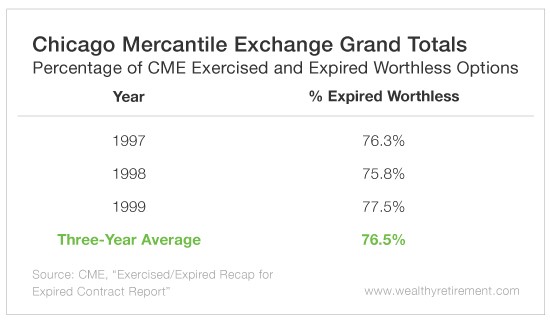The call option is the most popular option in the market.
It can be bought or sold. When it’s bought, the call option gives the buyer the right, but not the obligation, to buy the underlying stock at a preset price called the “strike price.”
[ad#Google Adsense 336×280-IA]For example, if you wanted to make a bet that Apple is going to $200 by the end of the year, you have two choices: You can buy 1,000 shares of Apple for $153,000, or you can buy a call option on Apple shares that expire in January with a strike price of $185 for about $8.
The latter would mean that your outlay to control 1,000 shares is about $8,000.
That’s a far cry from the $153,000 you would need to buy 1,000 shares today.
That’s also the lure of call options… They’re cheap compared to the stock, and they can have huge upside.
If Apple were to trade to $220, you would make $67,000 on the stock trade, or about 44%. But you would have $153,000 at risk.
On the option, you would make about $27,000 ($220 minus $185 minus $8), or more than 300%. But you have only $8 per share at risk.
Here’s the problem…
The call buyer succeeds maybe 20% to 25% of the time. That means he loses around 75% of the time.
Think about it for a second… If you were able to buy call options successfully all of the time or even half of the time, why bother buying the stock?
 Buying calls, especially those that expire in a few days, weeks or months is a loser’s game – unless there is a very strong basis behind the purchase.
Buying calls, especially those that expire in a few days, weeks or months is a loser’s game – unless there is a very strong basis behind the purchase.
When you buy a short-term call without a tried-and-true system, you are basically saying you can predict where the stock or market will go in the short term. I have yet to see someone be right on such predictions more than once or twice.
That said, there are times when buying a call option makes a lot of sense. Here are a couple:
- When a company is about to report earnings and the outcome is uncertain. If the earnings are in your favor, the stock could shoot higher and the option could pay off big time. With the advent of weekly options, your outlay is much smaller, and the chances of a much larger reward are greater. The reason I would use a short-term option is because it protects my downside. If the earnings are a bust, I stand to lose only what I invested.
- When a company is about to report the results of a major event. Usually, this applies to the biotech sector. Results from drug trials can send stock prices up by triple digits or down by 50% in a matter of minutes after the release. Using a call option limits your downside to the amount you invested and allows for unlimited upside.
- When a company is thought to be in play. Takeover speculation is just that… speculation. When you understand that you are speculating, using call options will limit your exposure to the downside.
The common theme here is that you should use call options when you are speculating, because the odds of making money from the trade are not in your favor. The attraction to call option buying is no different than buying a lotto ticket. The problem is that if it pays off once, you’re going to get hooked.
Call options can be traded in your retirement account and nonretirement account and require very little in the way of approval from your broker, as your risk is limited and known.
There are other times when using a call option actually makes sense and can actually be less risky for your portfolio. Next week, I’ll delve into using call options in ways that you can mitigate risk or increase returns with greater probability of success.
Good investing,
Karim
[ad#wyatt-income]
Source: Wealthy Retirement
